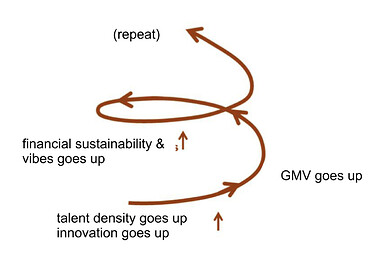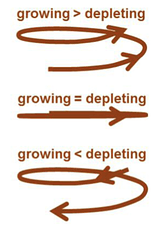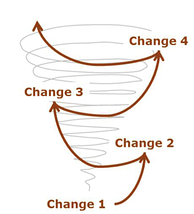Much credit/research for this post goes upstream to: Upward Spirals / Upward Spirals - bootstrapping systemic change in an organization.
Downward Spirals
The downward spiral is a metaphor for decline, a self-reinforcing process that depletes something of value
It can be described as a cycle of disinvestment or deterioration, as players withdraw resources from a system, an action that reduces its performance and prompts further withdrawals down the line.
Unfortunately, when we are part of a downward spiral, we almost always find it difficult to see a way out because the incentives in the situation often reward narrow, short-term thinking.
For example: Treasury goes down and that creates financial pressure, which means talent leaves. As contributors disinvest, short term incentives take hold. People leave and maybe even take IP or other assets with them. Staff turnover is hard on work output, and so innovation goes down and products are not shipped - creating rising costs and lost customers… This causes the cycle to repeat.
Upward Spirals
The Upward Spiral is the inverse of the downward spiral. The upward spiral is a metaphor for regeneration & renewal. A self reinforcing process that accretes something of value.
The spiral is simply the shape created by a self-reinforcing growth process. By definition, a spiral winds around a center, in a progressive expansion or contraction, a rise or fall.
What we see in Upward Spirals Is the accumulation of changes as the system iterates over time. We associate an upward spiral with growth, development, and evolution, as reflected in the architecture of spires and towers. The upward spiral is a meta-model for systemic change.
The upward spiral in this context is a metaphor for growth or “mutually reinforcing change that creates or regenerates something we value.”
For example: Talent density goes up, which means that innovation is happening. As we get momentum in the market, success breeds on success, GMV goes up. This causes vibes and financial sustainability to go up. This causes the cycle to repeat.
Ways to reverse a downward spiral
Heroic Change
With Heroic Change, change is likened to a journey or “trip to the moon.” In practice, it generally involves a strategic injection of resources and energy to orchestrate a “trip” from the old way to the new way.
The drawback is that it is resource intensive, so we may find we do not have enough fuel to get to our destination. If we have not reached our goal and have bulldozed past opposition, the system may swing back toward the other pole, stuck in oscillation rather than advancing.
Grassroots Change
By contrast, with Grassroots Change, we think of change occurring through “ripple effects.” It relies on many small-scale efforts, gradually winning converts until the new way replaces the old.
This approach allows for creative emergence, yet can fail to take off if it does not engage structural barriers that limit progress or if local efforts do not build on each other. If our experiments run out of energy, or if we have excluded important opposition, the system can swing back again toward the other pole.
Upward Spiral Approach
The upward spiral approach enables us to bootstrap change out of many small efforts.
- Center on the Asset
- Prime for Potential
- Invest in Increments
- Approach at the Right Angle
- Signal Through Action
- Listen and Amplify
Center on the Asset
The first step in building an upward spiral is to ask, What do we want to grow? The answer is usually some kind of asset that enables us to generate the results we want. (An asset refers to any enabling resource, infrastructure, or stock – physical or intangible.)
Application at Gitcoin: The key enabling resource/infrastructure Gitcoin is building is Allo. Allo becomes more valuable the more people use it for capital allocation. Capital Allocation as a market has trillion $$ TAM, so there is 10^7x upside here!. This is the asset to invest in!
Prime for Potential
The second step is to activate hidden potential in ourselves and others by asking, What might help us see ourselves and each other anew? What are we truly capable of? A fresh look provides the inspiration to invest new energy in a situation with negative history.
Application at Gitcoin: We need to build a culture (both in citizens and Grants Lab) that primes for potential. By investing in & retaining live players in both parts of the DAO, we will realize our potential.
Invest in Increments
The third step is to decide: How big a step should we take next? The ideal next step contributes to the core asset, yet is within the scope of what you can manage.
Application at Gitcoin: I like the “we release something at every conference we go to” pace that Grants Lab is on. We need to take bigger swings but still the fact we’re getting at-bats and some base hits is great ![]()
Approach at the Right Angle
The fourth step invites us to set our “angle of approach”: Where do we need to differ from expectations or reach out across lines? Where do we need to say “no”?
Application at Gitcoin: The only thing we need to reinvent is Capital Allocation. This is our central aim. Everything else we should take out of the box solutions that help us coordinate effectively around our central aim.
(Note 1 regret I have is that the DAO decentralized too fast in 2021-2022 and as a result, tried to reinvent governance AND its products, which was very costly and ineffective!)
Signal Through Action
The fifth step advises us not to start with talk, but to ask ourselves, How can we signal our commitment through action?
Application at Gitcoin: I think we should all have a bias towards action.
Listen and Amplify
If bootstrapping change requires many small, reciprocal actions, then we can drastically accelerate that process by paying closer attention to what is already underway. We can simply ask, What can we build on? How will we know when to take the next step?
Application at Gitcoin: I think that partner/grantee feedback is of paramount importance to listen to and amplify through the organization. There are other areas where we’ll need to Listen and amplify tho!
BootStrapping The Upward Spiral
At what point does a downward spiral tips to an upward one?
The answer depends on the balance between growing and depleting flows. Results improve as assets grows, which then enables reinvestment.
We can tip the spiral by increasing the growing function or reducing the depleting function. In this way, a small action can transform the functioning of the system as a whole.
The upward spiral approach enables us to bootstrap change out of many small efforts
Many intractable situations in business, cross-workstream collaborations, personal relationships, and DAO life can be improved through small, reciprocal actions among peers, leaders and followers, and citizens.
Feedback
What do you think? How would you like to see this applied at Gitcoin? What upward spirals should we generate?
Perhaps if there is interest, Ill host a twitter space or brainstorm about this!



